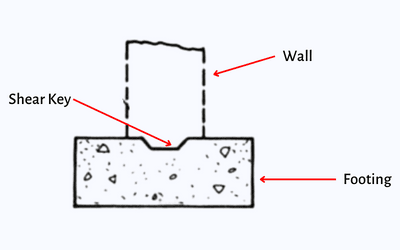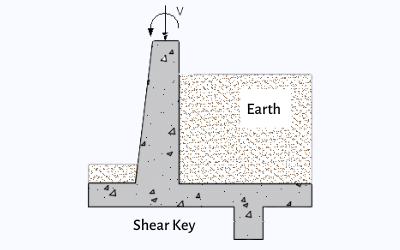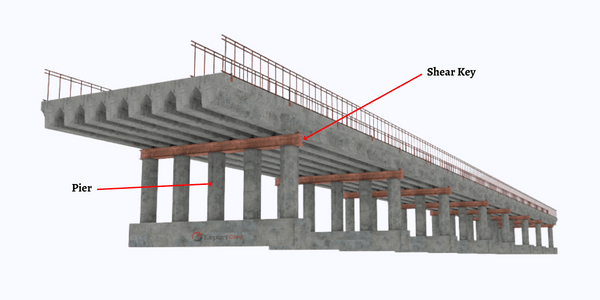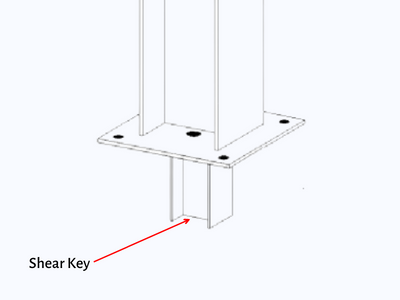Define shear key
Shear key is a part of a structural element which is used for stability against the lateral loads. The shear keys applications vary according to the nature of the loading and type of construction.

The shear key is constructed between two structural elements in most of the cases but for retaining wall like structures the shear key is attached to the main structure but resting in the soil provides the stability.
What is shear key in construction?
The shear key is primarily utilized to preserve the structural integrity of the structure; the shear force generated by applied or lateral loads is transferred between the structures at the joint by the shear key.
Shear key in retaining wall
The friction and any projection from the base resist the lateral loads that are applied on the retaining wall. The base can resist the later loads up to a certain extent based on the friction between the concrete and the rock. The shear key is needed to be designed depending on the applied loads for bending and shear.

Behaviour of shear key in retaining wall
The shear keys are not provided in thinner walls instead construction joints are provided above the base. With the thickness of the wall, the lateral loads increases, and shear links are provided to carry the shear forces. A horizontal construction is a good option as it is weak in shear resistance. A shear key is considered to be provided in the construction joint if the thickness of the wall is beyond 500mm.
Behaviour of shear keys in retaining wall foundations
Resistance to sliding will increase if the shear key is provided. The shear is generally provided as an extra part of the vertical stem and it extends below the bottom of the base. The additional passive resistance created by the shear key’s height is increased by the availability of the shear key. However, shear keys’ active pressure also rises at the same time. However, shear keys’ active pressure also rises at the same time.
Design of shear key for retaining wall
To increase the sliding resistance in retaining walls the shear keys are provided at the base. The provided shear keys should be proportioned in a way that the width of the shear key should be at least twice its depth to develop the strength of the key in shear instead of flexural as per ACI 317 – 17.
The shear key should be constructed 0.91 m from the tow of the footing, with width of 0.508 m and depth of 0.381 m.
Design of shear key in bridge
In bridges to provide support to the superstructure under lateral loads, the shear key is placed in the abutments of the structure. In resisting the seismic loads the shear keys in the bridge play a significant role.

The shear keys act as a sacrificial structural element to prevent the transmission of large seismic forces. In bridges, two types of shear keys are provided, the exterior shear keys and the interior shear keys.
Shear key in column
A different shear key in the form of a block of T-section or I-stub is welded onto the bottom of the base plate and is used to resist the shear force in the column at its base.
Function of shear key in column
Shear keys in columns primarily serve to augment the additional passive resistance created by their height; they also create active pressure. The shear key which is provided during the construction joint of the column stops the sliding of the column from the joint by increasing the factor of safety for sliding during the failure of structure.

Advantages of shear key
- It improves the bonding between concrete and surfaces
- The construction of shear key is not limited to cast-in-situ concrete
- It increases the resistance of lateral forces at the construction joint’s location
- The shear key is used to increase the joint surface’s shear resistivity and to connect two separately precasted components.
Disadvantages of shear key
- Needs skilled structural engineer for its designing concerns
- Extensive planning is needed
- Difficult and expensive to modify
Difference between shear key and construction joint
The construction joints are provided in the beams and slab, whereas the shear keys are to be provided in each slab and beam.
Importance of shear key in shear wall
To resist the lateral loads applied externally and internally, the shear keys are provided in the shear walls. The connection to the other walls is made by a wall’s projection. The shear key joints could be in provided in the vertical as well as the horizontal direction.
What is the purpose of shear key?
The main function or the purpose of shear key is to maintain the integrity of the structure. Only the shear force is allowed to be transferred through the shear key, the bending moment is not transferred through the shear key.
The shear key at the joint transfers the shear force due to the applied loads between the structures.
Shear key HSN code
HSN 8203 3000 is the HSN code for shear key.
Also Read: Common Mistakes on Construction Sites
Question and Answer
What is the alternate of shear key in retaining wall?
Reinforcement bars is the alternate of shear key in retaining wall
Why shear key is provided?
Shear keys are provided to restrict the lateral forces caused due to earth pressure, water pressure, earth quakes etc. on the structural members. The structures includes bridges, the residential building’s basement, retaining walls etc.


The Shear Key plays a vital role in supporting lateral forces in buildings, often positioned between the foundation and the structure. Its primary function is to maintain stability and effectively transfer shear forces. The significance of the key is its capability to prevent sliding, despite the potential for heightened complexity and expenses. A well-executed design maximizes safety and operational efficiency.